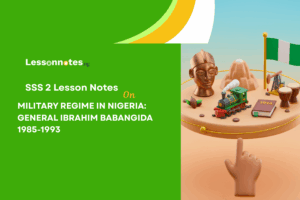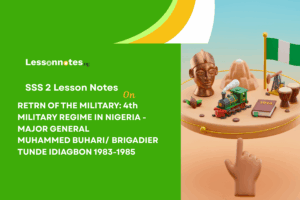Third Military Regime In Nigeria 1975-1979 : General Murtala Muhammed & General Olusegun SS2 Nigerian History Lesson Note
Download Lesson NoteTopic: Third Military Regime In Nigeria 1975-1979 : General Murtala Muhammed & General Olusegun
The Third Military Regime in Nigeria began on July 29, 1975, when General Murtala Muhammed took power from General Yakubu Gowon. Gowon had been Nigeria’s leader since 1966 (during the Civil War). Many Nigerians were unhappy with Gowon because he did not keep his promise to return the country to civilian rule. There were also many complaints about corruption in his government.
General Murtala Muhammed was a popular military officer who had fought in the Nigerian Civil War. When he took power, he made General Olusegun Obasanjo his deputy (second-in-command). This new government promised to fight corruption and return Nigeria to civilian rule quickly.
The Murtala Muhammed Period (July 1975 – February 1976)

Government Changes
When Murtala Muhammed took power, he made big changes right away:
- He fired many government workers who were seen as corrupt or not doing their jobs well
- He removed all the state governors who had served under Gowon
- He set up a committee to look into corrupt practices
- He created seven new states in Nigeria, making the total number 19
- He announced a plan to move Nigeria’s capital from Lagos to Abuja (a more central location)
Fighting Corruption
Murtala Muhammed was known for his strong stand against corruption. He:
- Started investigations into the wealth of former government officials
- Took back government property that had been wrongly given to private people
- Made government officials declare their assets (show what they owned)
- Fired over 10,000 public servants for corruption, laziness, or being too old
Return to Civilian Rule
One of Murtala’s most important actions was announcing a clear plan to return Nigeria to civilian rule. This plan had these steps:
- Creating more states (which he did)
- Setting up a committee to write a new constitution
- Holding local government elections
- Holding state elections
- Holding national elections
- Handing over power to civilians by October 1, 1979
Foreign Policy
Murtala also made Nigeria’s voice stronger in world affairs:
- He spoke strongly against apartheid (racial separation) in South Africa
- He supported freedom fighters in Angola
- He made Nigeria a leader in African affairs
The Assassination
Sadly, Murtala Muhammed was killed on February 13, 1976, in a failed coup attempt. His car was attacked in Lagos traffic. The coup was led by Lieutenant Colonel Buka Suka Dimka, but it failed because most of the military stayed loyal to the government. After Murtala’s death, his deputy, General Olusegun Obasanjo, became the new Head of State.
The Obasanjo Period (February 1976 – October 1979)

Continuing Murtala’s Policies
When General Obasanjo took over, he promised to continue the policies started by Murtala Muhammed. He kept the same team of officers and maintained the plan to return to civilian rule. He often referred to the government as the “Murtala/Obasanjo administration” to show respect for the late leader.
Economic Reforms
Obasanjo faced economic challenges during his time as leader:
- He started the “Operation Feed the Nation” program to increase food production
- He created the Land Use Act of 1978, which changed how land ownership worked in Nigeria
- He built new oil refineries to process Nigeria’s oil locally
- He started the National Youth Service Corps (NYSC) to promote unity among young Nigerians
Education and Culture
The Obasanjo government made important changes in education and culture:
- Universal Primary Education was introduced to give all children free primary education
- New universities were established across the country
- The Festival of Arts and Culture (FESTAC) was held in 1977, bringing artists from African countries and the black diaspora to Nigeria
Infrastructure Development
This period saw many development projects:
- New roads, bridges, and highways were built across the country
- The plans for building the new capital city of Abuja moved forward
- Airports were upgraded in major cities
- New seaports were developed
The Return to Civilian Rule
Obasanjo faithfully followed the transition plan that Murtala had set out:
- A Constitutional Drafting Committee created a new constitution
- The ban on political activities was lifted in September 1978
- Five political parties were allowed to register
- Elections were held at local, state, and federal levels
- On October 1, 1979, Obasanjo handed over power to the elected civilian president, Alhaji Shehu Shagari
Achievements of the Third Military Regime
Political Achievements
- Successfully returned Nigeria to civilian rule
- Created more states, which helped give more groups representation
- Started the move of the capital from Lagos to Abuja
- Made the government less corrupt
- Strengthened Nigeria’s position in African and world affairs
Economic Achievements
- Used oil money to start many development projects
- Built new refineries and factories
- Expanded roads and other infrastructure
- Started programs to increase food production
- Created the Nigerian National Petroleum Corporation (NNPC)
Social Achievements
- Improved education access through Universal Primary Education
- Started the National Youth Service Corps
- Celebrated Nigerian and African culture through FESTAC
- Created jobs through new development projects
- Reduced corruption in public service
Challenges and Criticisms
Challenges Faced
- The sudden death of Murtala Muhammed was a big setback
- Oil prices were unstable, affecting government income
- There were still tribal and regional tensions
- The military had to be convinced to return to the barracks
- The new democratic system needed time to develop
Criticisms
- Some people felt the military rule, even if reformed, was still not democratic
- The quick firing of many civil servants caused hardship for many families
- Some economic policies increased Nigeria’s debt
- The transition to democracy may have been too rushed
- Military habits still influenced the new civilian government
Legacy
The Third Military Regime under Murtala Muhammed and Olusegun Obasanjo is often seen as one of the better periods of military rule in Nigeria. Its main legacy was:
- Showing that the military could voluntarily give up power
- Setting up systems to fight corruption
- Strengthening Nigeria’s voice in international affairs
- Using oil wealth for development projects
- Creating a path to democracy that was actually followed
Many Nigerians still remember Murtala Muhammed as a hero who might have transformed Nigeria if he had lived longer. Obasanjo would later return as Nigeria’s civilian president from 1999 to 2007, after Nigeria returned to democracy following more periods of military rule.
The Third Military Regime showed both the potential benefits of strong leadership and the importance of democratic rule. While it achieved many things in a short time, it also showed that Nigeria’s best future would be under a government chosen by the people.






















